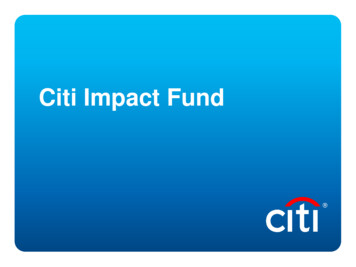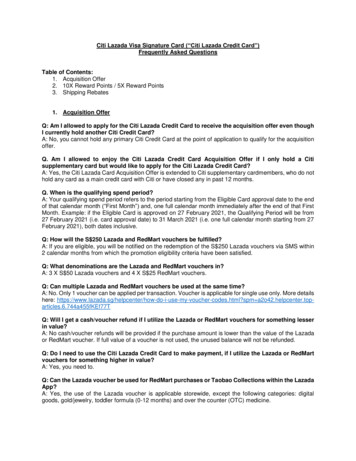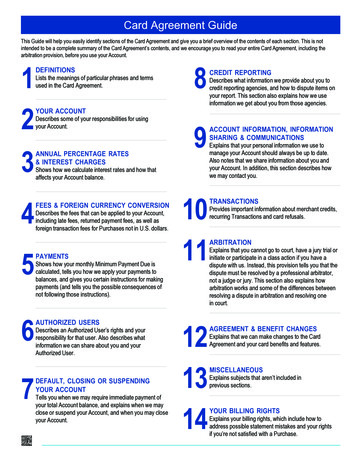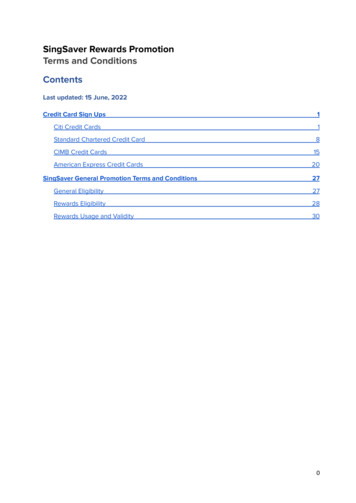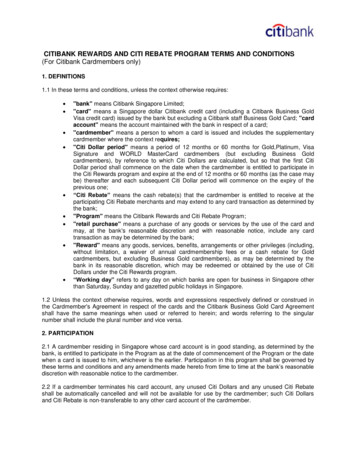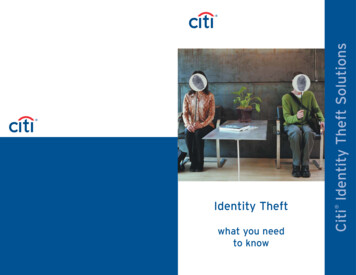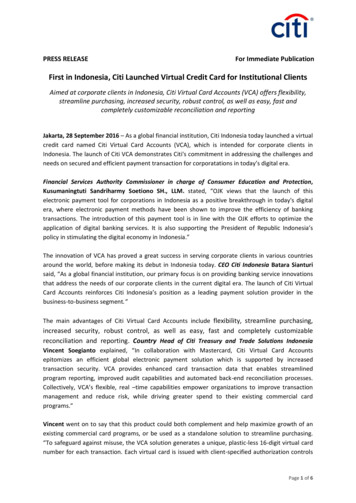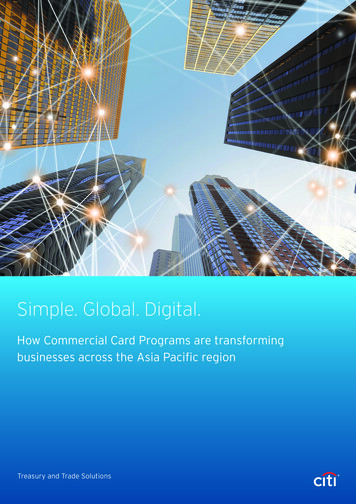
Transcription
Simple. Global. Digital.How Commercial Card Programs are transformingbusinesses across the Asia Pacific regionTreasury and Trade Solutions1
Executive SummaryCommercial cards are among the most effective and efficient tools for the managementof corporate spending. In compiling this research Citi spoke to 46 decision makers from42 separate companies across a range of industries, each a senior corporate figure in theAsia Pacific region. The APAC survey gathered insights on both current programs andfuture initiatives from multinationals and top-tier corporates working in areas as diverseas technology, manufacturing, healthcare and the public sector.Increasing global spend came out as thetop priority for respondents.2017 (increase from previous year)APAC spendvolumeB2B volumeMany corporates are expanding the useof commercial cards to alternative flowssuch as travel and entertainment (T&E) orprocurement, while migrating from checksand ACH payments.76%of respondents alreadymandate the use ofcorporate cardsfor travel.24%48%Program digitization and technological enhancements are also a key request from clients,as they seek to increase visibility and control amid more stringent compliance demands,improve operational strategies and enhance cardholders’ convenience.Survey Respondents Want Solutions That Are SimpleGlobalDigitalClients value Citi’shigh levels of79%have a shared servicecenter (SSC)45%use SSC to managetheir corporate cardprogram in Asiaglobal proprietaryfootprint25%use an expensemanagement system(EMS)global reportingtools24%95%merchantacceptance29%80% 44%Over 80% ofrespondent’scardholders useCitiManagerto view theirstatementsand apply for acard.but only 44% use CitiManager forover half of their requests.This study sets out five areas of best practice where readers can benefit from the experiences and valuable insights of the multinationalsand regional corporates that took part in the survey. This is coupled with Citi’s long record of offering a wide range of commercial cardprograms in the region and worldwide.Citi Commercial Cards is distinguished by its commitment to building solutions that are simple, global and digital. The findings here revealthat these aspirations are shared by leading companies in Asia Pacific and around the globe, and this report seeks to explain how they canbest be realized.2
Key Insights:Five Steps to Best PracticeTo get the most from their commercial card program, companies should:1. Choose the right partnerCiti Commercial Cards has proprietaryissuance in 14 APAC markets with therecent addition of Vietnam in Q4 2018.2. MeasureMandate cards and enforce their use forall eligible purchases to maximize spendand controls.3. Analyze4. Identify OpportunitiesManage and track card programexpenditure and key parameters regularly.Get card providers to deliver analysisand trend information rather than simplytransactional data or statistics.5. InnovateImprove process efficiency andcardholders’ experience by going digital.Manage spend centrally to gain greatervisibility and to identify opportunities forcost reductions or controls.Best Practice:Manage and trackcard programexpenditure moreefficiently.To support clients, Citi offers advisory events including our client academy and clientconferences. These provide an opportunity to share best practices and benefit fromCiti’s network.Leverage your Shared Service Centers (SSCs)Centralization of travel and other spend makes it far easier to monitor card program expenditure and measure key metrics. ThroughSSCs and global tools such as CitiManager, companies can also drive operational efficiencies. Our survey showed that the vast majority ofrespondents have measures in place to do just that:79% of respondentshave a SSC.45% of whom use it tomanage their corporatecard program in Asia.Just 33% use in-country programadministrators (PAs) to manage theirprograms.One particularly important aspect of ensuring program compliance is delinquency management. Depending on the size of the company,these activities might require a specialized team or a tailored set of tools to conduct effective transaction data analysis. Only 7% of respondents do not monitor card delinquency in their organizations. Among the large majority of respondents that do monitor card delinquencies, 48% use a combination of tools, such as expensemanagement systems and Citi Custom Reporting Systems (CCRS).3
Keep a Close Eye on SpendingCiti offers a range of products to help clients with their management and tracking of program spend. In addition to the Citibank CustomReporting System (CCRS), CitiManager offers graphical program dashboards which provide a snapshot of the entire card program. Thesecan easily be shared with executives as a high-level summary.There are three types of dashboards:The Program Performance Dashboardallows users to track key program metricsrelated to credit usage and compliancetrends, including monthly delinquencystatuses, fees charged, credit losses andcounts, as well as active cards.The Vendor Summary Dashboard providesthree summary reports for users toanalyze and leverage vendor data. This canbe used to optimize procurement spendingand capitalize on economies of scale.The Transaction Summary Dashboardprovides key analytics on card usageand program growth. It can be used togenerate intra-company comparisons andbenchmarking metrics on trends related tocard spend and transactions.Remain Alert at all TimesCiti offers over 30 specificallytailored email and SMS alerts.Cardholders and PAs can electto receive important accountinformation (such as statementready, payment due, declinedtransactions, fraud management)directly and promptly to theirdesignated smartphone forimmediate action.4
Analyze Your M&E SpendMeeting and Events spend is core in generating business: among marketing activities, it is seen as the second largest revenue driver formany organizations after website marketing.2531%manage M&E centrally69%have on’stotal revenuespent on M&E.Business-tobusiness marketingbudget.of survey respondents have anM&E policy.22%72%use the new wave of digitalsolutions such as Cventsoftware to manage theM&E process.of respondents use card products tocover M&E related spend.Companies are therefore missing out on an opportunity to gain potentially significantbenefits such as compliance, control and transparency. Citi has partnered with Cvent tohelp address these challenges. Our goal is to simplify the meetings management process,while eliminating costs associated with manual processing due to a lack of integration. As aresult, we can provide increased overall control and visibility for the organization.Best Practice:Put digital andpayment toolsin place thatdrive complianceand providetransparency.Solution RecommendationCiti VCA and traditional cards are integrated into the Cvent tool to support vendor paymentdirectly from the Cvent platform. The solution simplifies budgeting, payment, reconciliation,and management. It supports approval-based entitlement, spending controls, enhanceddata and consolidated reporting for meetings management and financial control.5
Choose the Right Bank for YouDifferent banks have widely varying capabilities and footprints and it is essential to opt for the most suitable partner. Our survey found thatcorporates need globally consistent tailored, customized card solutions, developed in collaboration with their bank.The right bank can deliver a full suite of payment options across a firm’s geographic footprint, adapting and customizing the program inline with a company’s objectives. Astute banks also take a consultative approach, understanding geographic and industry nuances to helpidentify and quantify the opportunity across your footprint and support the business case for change.Moreover, banks help translate stakeholder input, requirements, and objectives into a comprehensive program design.Citi is seen by clients as having a competitive edge over other card providers for a number of reasons:Citi cards are accepted at over 40 millionmerchant locations and 1.9 million ATMsin over 200 countries and territories (acapability valued by 29% ofsurvey respondents).Citi has the broadest proprietary network,with a footprint in 14 markets in APAC.More than a third of respondents valueCiti’s global capabilities, which facilitateexpansion for the region’s companies.Citi operates in over 100 countries and offers 64 local currency card programs, 45 currencies and over 27 languages. To enable clients toachieve efficiency, visibility and control, Citi delivers consistent programs, products, implementation and service around the globe.6
Technology Makes the DifferenceSurvey respondents particularly value Citi’s global reporting tools, with 24% citing them asa key reason for choosing Citi.GlobalReportingTools24%Citi’s unified global technology system and single data repository provides PAs with a complete view into global program data, through aminimal number of reporting tools (CCRS/CitiManager), with extractable common data attributes and standardized reporting. As a result,they have unmatched control and visibility.Many of Citi’s competitors rely on partner banks or their consumer cards platforms for issuance. Citi’s proprietary footprint means thatclients always experience high-quality, Citi-managed global programs with consistent capabilities and service.30% Citi Asia Commercial Cards continues to re-invest over 30% of net income into ourproducts and services. We are focused on global expansion, streamlined management andservicing and our core capabilities.Citi also goes the extra mile for clients by offering global file integration for EMS and enterprise resource planning (ERP) systems, such asSAP, Concur, Oracle and JD Edwards. Both format and frequency can be customized.Best Practice: Make full use of Citi’s online global reportingand file integration tools for more streamlined management.7
Commercial Card Programs WorkBest When All Stakeholders Buy InSenior management support is vital fora commercial card program to reach itsfull potential. It is important to educateall stakeholders on the benefits of acard program in order to make sure theprogram is followed through. A card based payment platformis especially relevant to corporatetreasurers, as a useful tool in assistingglobal expense management andcashflow while balancing companies’liquidity and profitability. Unsurprisingly, corporate treasury isinvolved in making decisions regardingthe choice of corporate card providerfor 90% of survey respondents.T&E expenses can account for a significant proportion of a company’s budget. So it isno surprise that many companies are now shifting from traditional payment tools tothe use of commercial cards.76%36%of respondentsmandate the use ofcorporate cardsfor travel.of respondents donot have a P-Cardprogram.Citi’s internal data corresponds with thesurvey finding that global spend growth isthe top priority for clients.Jan-Apr 2018(increase from previous year)Top ten commercial cardclients spend increase23%Best Practice:Mandate cardsand enforce useof cards for alleligible purchases,to maximizespend andcontrols.Around half of those plan to adopt P-Cardsto replace checks, ACH and other methodsPrograms are Available to Meet a Variety of RequirementsCiti offers a wide range of commercial card products to meet your needs and deliver significant value.8 T&E card programs capture spend such as air, rail, hotel, restaurant and taxis and have flexible program parameters. They simplifyemployee travel and streamline administration by using data feeds into Expense Management Systems (EMS), helping to improveefficiency and cut costs. Central travel accounts store ‘lodged’ account details with a corporate’s Travel Management Company (TMC) to capture air and hotelspend for employees without cards. P-Card programs offer flexible controls, with a variety of spend restrictions (such as single transaction limits and merchant categorycode blocks) to control buying and facilitate compliance. This method eliminates purchase orders and invoice processing (savingadministrative costs) and is available as plastic or a ‘ghost’ card. Virtual Card Account (VCA) programs can be used for card-not-present transactions via three flexible interface options: web, file andapplication programming interface (API). VCA generates unique virtual card numbers with transaction-level controls such as amount,validity period, and supplier. They also enable additional data capture at time of virtual card number request, making reconciliationmore straightforward.
Ensure Effective Use of Digital ToolsOnline Applications (OLA)Citi offers many useful digital toolswhich enhance cardholders’ experienceand enable PAs to focus their efforts onprogram optimization and growth. OnlineApplications (OLA) allow employees toapply for a card and/or PIN simply andconveniently. Furthermore, they cantrack the end-to-end status of their cardapplication, including approvals. With OLA,the processing of applications is quickerand cards are delivered faster.Online Maintenance (OLM)Online Maintenance (OLM) enhances thedigital footprint of the program, makingavailable real-time maintenance updatessuch as changes to card credit limits,changes to address, block/unblock andcard cancellation.Online Statements (OLS)Online Statements (OLS) offer benefitssuch as faster access to accountstatements, access to statements anytime,anywhere, the ability to retrieve up to 36months of statements and statementsdirectly via email.However, these tools are only valuable ifthey are used effectively.CitiManager is used to access80%83%OLSOLATellingly, just 44% of respondents useCitiManager for more than half of theirrequests. As a result, they are missingout on process efficiencies and failing togive their cardholders the best possibleexperience.Citi intends to address these challengesand encourage greater use of online toolsby communicating more effectively withPAs and providing WebEx training sessionsto facilitate familiarity with CitiManager.WebEx training sessions are particularlyvaluable for clients as they are available ata time that suits the organizationor individual.Citi also plans to push e-statementsdirectly to cardholders’ registeredemails and will run an e-campaign toremind all PAs and cardholders to accessCitiManager for their e-statements andprogram performance (against establishedobjectives). Meanwhile, Citi is in theprocess of eliminating paper statements inall markets.Best Practice:Improve processefficiency andcardholders’experience bygoing digital.Partnering for SuccessThe findings from our study show remarkable consistency with a similar survey conducted by Citi Commercial Cards in North America in2017. Companies in both regions are growing their programs and spend while looking for opportunities to further centralize, in order toimprove efficiency and lower costs.In Asia Pacific more than three-quarters of respondents use the same commercial card provider in every market across the region,for example.To a large extent, this outcome is to be expected. The world is more connected than ever and companies which operate globally are workingto align their business practices.Yet the significant advances made by companies in Asia Pacific are not just the preserve of multinationals. Top tier corporates from theregion are fast catching up with North American and other global corporates in terms of digital adoption. In many cases, their fast pace ofregional and global growth is driving a strong push for simplification. This, in turn, is spurring the demand for greater global consistencyfrom their partners.In such an environment, it has never been more important to work with a truly global bank that can help you build globally consistent digitalcards programs. Citi looks forward to working closely with its valued partners in 2018 and beyond to achieve these important goals.For more information, please cial-cards/9
Treasury and Trade Solutionsciti.com/tts10 2018 Citibank, N.A. All rights reserved. Citi and Arc Design and CitiManager are registered service marks of Citigroup Inc.CTA4362 October 2018
Citi Commercial Cards is distinguished by its commitment to building solutions that are simple, global and digital. The findings here reveal that these aspirations are shared by leading companies in Asia Pacific and around the globe, and this report seeks to explain how they can best be realized. have a shared service center (SSC) use SSC to manage
